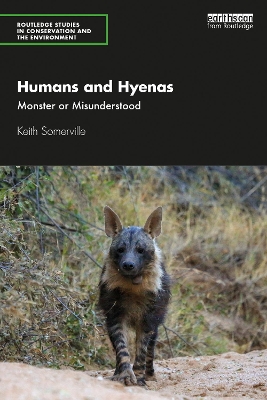Routledge Studies in Conservation and the Environment
2 total works
Humans and Hyenas examines the origins and development of the relationship between the two to present an accurate and realistic picture of the hyena and its interactions with people. The hyena is one of the most maligned, misrepresented and defamed mammals. It is still, despite decades of research-led knowledge, seen as a skulking, cowardly scavenger rather than a successful hunter with complex family and communal systems.
Hyenas are portrayed as sex-shifting deviants, grave robbers and attackers of children in everything from African folk tales through Greek and Roman accounts of animal life, to Disney’s The Lion King depicting hyenas with a lack of respect and disgust, despite the reality of their behaviour and social structures. Combining the personal, in-depth mining of scientific papers about the three main species and historical accounts, Keith Somerville delves into our relationship with hyenas from the earliest records from millennia ago, through the accounts by colonisers, to contemporary coexistence, where hyenas and humans are forced into ever closer proximity due to shrinking habitats and loss of prey. Are hyenas fated to retain their bad image or can their amazing ability to adapt to humans more successfully than lions and other predators lead to a shift in perspective?
This book will be of great interest to students and scholars in the environmental sciences, conservation biology, and wildlife and conservation issues.
This book explores the fascinating and complex lives of the honey badger, the African jackals (black-backed and side-striped), African golden wolves, and Eurasian golden jackals. In recent years, interest in these creatures has grown exponentially, through wildlife documentaries and media clips showing the aggressive, fearless, and tenacious behaviour of the honey badger, with jackals often presented in a supporting role.
Written by renowned journalist and educator Keith Somerville, this accessible volume includes historical narratives, folklore, and contemporary accounts of human–wildlife relationships and conflicts. It traces the evolution of the species; their foraging and diet; the development of their relationships with humans; and their commensal, kleptocratic, and symbiotic relationships with other carnivores, raptors and birds. It also charts the recent expansion in European jackal numbers and ranges, now including as far west as the Netherlands and as far north as Finland.
Blending historical observations by non-scientists, colonial officials, administrators, and early conservationists with contemporary scientific accounts, it presents a new multidisciplinary approach that will interest researchers, scientists, and students in wildlife conservation, human–wildlife relations, zoology, biology, and environmental science.

